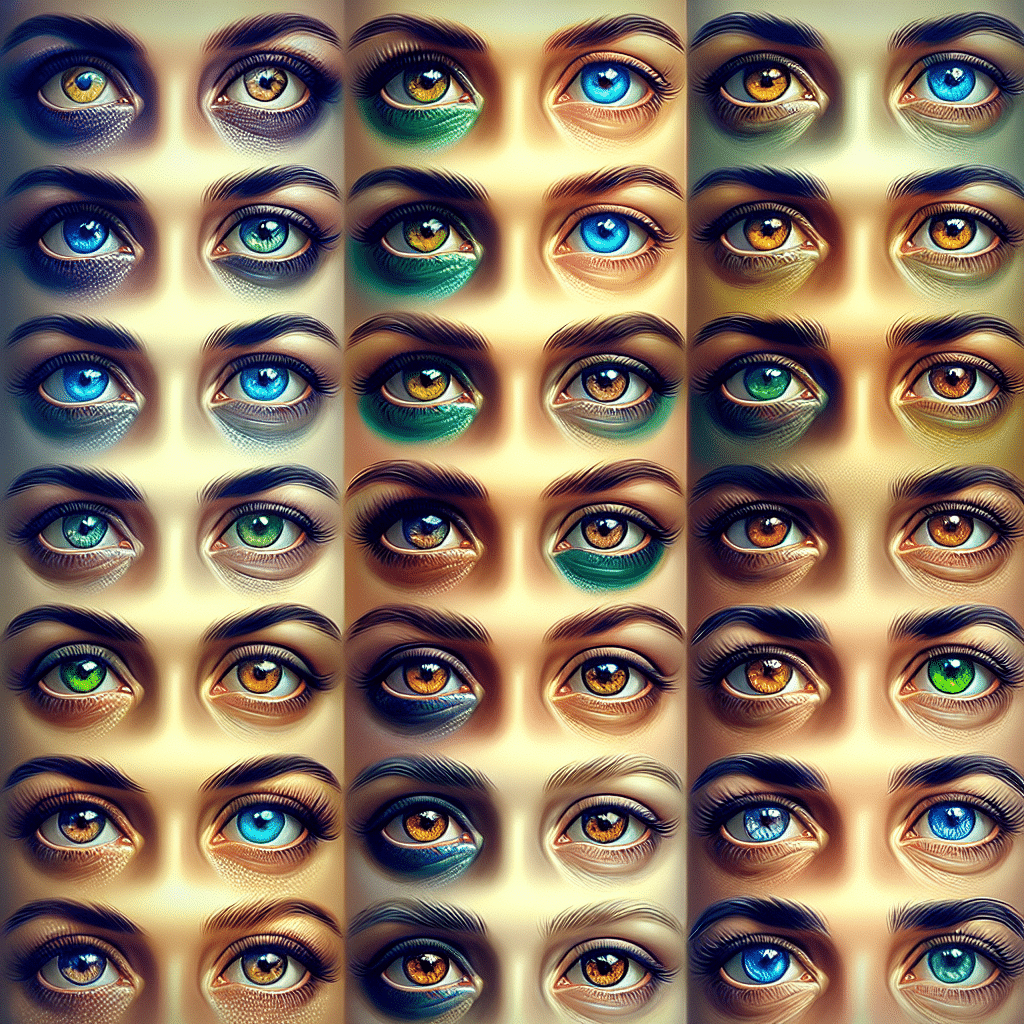Eye Colors of Celebrities
Ben Mendelsohn’s Blue Eyes
Ah, Ben Mendelsohn, the man with the captivating blue eyes that can pierce through the toughest of movie villains or charm the socks off any audience. Known for his roles in films and series like “Rogue One” and “The Outsider,” he has a pair of blue eyes that could probably light up a dark room—provided there’s no competition from the sun! According to reliable sources, Ben’s azure orbs are as iconic as his performances (Naija News).
| Actor Name | Eye Color |
|---|---|
| Ben Mendelsohn | Blue |
| Riz Ahmed | Brown |
| Michael Fassbender | Green |
| Steve Carell | Blue |
| Mahershala Ali | Brown |
Importance of Eye Color
Eye color is more than just a pretty feature; it is a conversation starter, a mood enhancer, and sometimes, an audition requirement! The importance of eye color in the film industry is undeniable. Directors often select actors based on how their eye color complements their character’s personality or the overall aesthetic of the film. For example, a villain with dark, brooding eyes might be more intimidating than one with sparkling blue eyes—unless, of course, that villain is Ben Mendelsohn.
In the grand tapestry of Hollywood, eye color adds a splash of uniqueness to each actor’s persona. It contributes to their character portrayal and can evoke certain emotions from the audience. So, the next time someone says “the eyes are the windows to the soul,” just nod and remember Ben Mendelsohn’s piercing blue gaze while you ponder the deeper meanings of eye color in cinema.
For more eye colors of your favorite stars, check out our section on movie star eye color and see how your favorites stack up against Ben!
Genetics and Eye Color
Understanding the eye color of celebrities like Ben Mendelsohn involves diving deep into the genes that determine those striking hues. It’s not as simple as flipping a coin; it’s more like a genetic soap opera with multiple characters involved.
Genetic Determinants
Eye color inheritance was initially thought to be as straightforward as a Mendelian trait, with brown eyes being dominant and blue eyes recessive. However, recent research has revealed that eye color is actually a polygenic trait. This means multiple genes work together to create the beautiful array of eye colors we see. Key genes implicated in this colorful drama include OCA2, TYRP1, MAPT, and MYO5A (Nature).
Here’s a quick table summarizing some common eye colors and their genetic associations:
| Eye Color | Gene Association |
|---|---|
| Brown | OCA2, HERC2 |
| Blue | OCA2, TYRP1 |
| Green | A mix of OCA2 and other genes |
| Hazel | A blend of brown and green traits |
Iris Pigmentation Factors
The final adult iris color doesn’t come packaged with a bow at birth. For example, Caucasian infants often have blue eyes due to a lack of pigment-producing cells called stromal melanocytes. By the time they hit the age of 3 to 5 months, their eyes usually develop their true colors (Nature).
Several factors come into play when determining the color of the iris:
- Pigment Granules: These are located within the posterior pigment epithelium and play a significant role in the overall color.
- Concentration of Pigment: The amount of pigment present in the iris’ stromal melanocytes directly affects the depth and richness of color.
- Type of Melanin: The nature of the melanin pigment produced within the iris can lead to variations in color.
- Light-Scattering Properties: The extracellular stromal matrix has its own light-scattering and absorption properties, which can further influence how we perceive eye color.
Isn’t it fascinating how much science is behind the simple act of staring into someone’s eyes? So, next time you gaze into Ben Mendelsohn’s captivating blue eyes, remember there’s a whole genetic saga behind that shimmering color! For more fun, check out the movie star eye color and learn about the eye colors of other celebrities.
Changing Eye Color
For those looking to shake things up a bit, changing eye color is a fun way to switch up one’s look without a complete overhaul. While it’s not possible to physically change the natural eye color of the iris, there are some creative methods to achieve a new gaze. Let’s dive into the world of colored contact lenses and other eye color alteration techniques.
Colored Contact Lenses
Colored contact lenses are the Hollywood secret that many stars use to enhance their eye color. These lenses come in various styles, allowing individuals to opt for subtle changes or dramatic transformations. For instance, one can wear clear green-tinted lenses to create a captivating aqua look or opaque eye-color-changing lenses for a complete overhaul to hazel or brown (Quora).
Here’s a quick comparison of colored contact lenses:
| Lens Type | Description |
|---|---|
| Clear Tint | Subtle color enhancement, perfect for a natural look. |
| Opaque Lens | Dramatic change, completely alters eye color. |
| Prescription Option | Corrects vision while changing eye color. |
These lenses can be a fabulous choice for those special occasions or just for fun. However, it’s essential to ensure they are safe and properly fitted to avoid any eye discomfort or complications.
Eye Color Alteration Techniques
While colored contacts are the most popular and practical choice, some might wonder about other techniques to achieve a different eye color. Unfortunately, there are no scientifically endorsed methods to change the actual color of the iris. Eye color is primarily determined by genetics, involving multiple genes that contribute to its hue. Recent studies have revealed that eye color inheritance is a polygenic trait, meaning it doesn’t follow simple dominant and recessive patterns (Nature).
Despite this, it’s fascinating to see that some congenital anomalies can result in unique eye colors or patterns, such as heterochromia, where one eye is a different color from the other. However, these changes are not something one can actively pursue; they just happen to some lucky individuals!
For those interested in a more long-term change, it’s crucial to remember that the safest method involves using colored contact lenses. Always consult with an eye care professional before making any changes to your eye color, especially if you are considering prescription options.
Whether someone is channeling their inner Ben Mendelsohn or just wanting to play around with their look, changing eye color can add a hint of fun and flair to any outfit. So, go ahead and explore those dazzling shades!
Eye Color in Film
Impact of Eye Color
Eye color can dramatically alter the perception of a character in films. It can evoke emotions, suggest personality traits, or simply add to the aesthetic appeal of an actor. For instance, actors like Ben Mendelsohn, with his captivating blue eyes, often bring depth and intrigue to their roles. The impact of eye color goes beyond mere appearance; it can influence audience perception and character believability.
Consider the following table illustrating how different eye colors are often perceived in film:
| Eye Color | Common Perceptions |
|---|---|
| Blue | Trustworthy, calm, and approachable |
| Brown | Strong, reliable, and grounded |
| Green | Mysterious, alluring, and passionate |
| Gray | Intense, enigmatic, and wise |
These perceptions can shape the narrative, adding layers to character development. It’s no wonder filmmakers pay close attention to the eye colors of their cast.
Eye Color in Character Portrayal
In character portrayal, eye color can play a pivotal role in defining an actor’s on-screen persona. For instance, Ben Mendelsohn’s blue eyes are a key aspect of his portrayal of Talos in Secret Invasion, where he navigates the complexities of a character that is both formidable and relatable. His eye color helps convey a range of emotions, from vulnerability to cunning intelligence.
Actors often use their eye color to enhance their performances. For example, those with striking eye colors may receive roles that highlight their unique traits. The following table summarizes some notable actors and their eye colors, showcasing how eye color has contributed to their iconic roles:
| Actor | Eye Color | Notable Role |
|---|---|---|
| Ben Mendelsohn | Blue | Talos in Secret Invasion |
| Emilia Clarke | Brown | Daenerys Targaryen in Game of Thrones |
| Riz Ahmed | Brown | Bodhi Rook in Rogue One |
| Natalie Portman | Brown | Padmé Amidala in Star Wars |
Eye color not only enhances an actor’s appeal but also influences the characters they portray. When casting directors consider eye color, they often look for a visual harmony between the actor and the role to enhance storytelling. For more insights on how eye color affects movie star appeal, check out our article on movie star eye color.
Fun Facts About Eye Color
Eye Color Myths
Ah, the mysteries of eye color! Many myths surround this fascinating topic. One common belief is that a person with blue eyes must come from a lineage of blue-eyed ancestors. While it sounds romantic, it’s not entirely true. Studies show that eye color inheritance is more complicated than that and involves multiple genes (Nature). It’s like a genetic game of poker—lots of players and unexpected outcomes!
Another popular myth is that people with lighter eye colors have better vision than those with darker hues. Spoiler alert: this isn’t true either. Eye color does not determine visual acuity. So, whether someone has sparkling blue eyes like Ben Mendelsohn or deep brown ones, their ability to see the world clearly is not tied to the color of their irises.
Here’s a quick table summarizing some popular myths and the truths behind them:
| Myth | Truth |
|---|---|
| Blue eyes mean you have blue-eyed ancestors. | Eye color inheritance is complex and involves multiple genes. |
| Lighter eyes have better vision. | Eye color does not affect visual acuity. |
| Eye color can change drastically with age. | While some changes can occur, drastic shifts are rare. |
Rare Eye Color Anomalies
Eye color can get even more interesting with rare anomalies. One such phenomenon is heterochromia, where a person has two different colored eyes or two colors within one eye. This can occur as a congenital condition or due to injury. Imagine rocking a pair of mismatched shoes but on your face! Celebrities like Kate Bosworth and David Bowie have showcased this anomaly, turning heads everywhere they go.
Another unique occurrence is the primary iris stromal cyst, a rare condition where cysts form within the iris. These can lead to visual loss if they grow large enough to obstruct vision. Talk about a surprise twist in your eye health story (Nature)!
For a fun fact, did you know that the final adult iris color isn’t present at birth? Caucasians often have blue irises as newborns due to a lack of pigment. By around three to five months, their true adult color emerges, potentially leaving parents questioning if they got switched at birth.
Here’s a handy table to illustrate some rare eye color anomalies:
| Anomaly | Description |
|---|---|
| Heterochromia | Two different colored eyes or two colors within one eye. |
| Primary Iris Stromal Cyst | Rare cysts that can affect vision if they grow large. |
| Neonatal Blue Eyes | Caucasian infants often have blue eyes that change color by age 3–5 months. |
Eye color is not just a simple trait; it’s a captivating blend of genetics, biology, and a sprinkle of mystery. Whether discussing the eye color of your favorite movie stars like Riz Ahmed or Natalie Portman, these facts add an entertaining twist to your knowledge of the beautiful spectrum of eye colors!
Trivia on Eye Color
Celebrities and Eye Color
When it comes to the dazzling world of Hollywood, eye color can be as striking as the performances themselves. Take Ben Mendelsohn, for example; he sports a captivating set of blue eyes that could make even the most stoic of characters seem emotional. Naija News confirms his blue eye color, which aligns perfectly with his roles that often require a touch of brooding intensity.
The impact of eye color in Hollywood is not to be underestimated. It can influence casting decisions and character development. Here’s a humorous take on how different eye colors might impact a celebrity’s career choices:
| Eye Color | Possible Role Types |
|---|---|
| Blue | The brooding hero, misunderstood villain |
| Green | The enchanting love interest, mysterious stranger |
| Brown | The reliable best friend, wise mentor |
| Hazel | The quirky sidekick, charming trickster |
From the dependable brown-eyed actors like Steve Carell to the mesmerizing green-eyed talents like Lupita Nyong’o, eye color often becomes a talking point among fans. It’s like their eye color has a résumé of roles that fit perfectly with their hues!
Eye Color and Personal Style
Eye color doesn’t just impact casting; it also plays a significant role in personal style! Celebrities often use their eye color to enhance their overall look. For instance, blue-eyed stars might opt for outfits in shades of blue to make their eyes pop, while green-eyed beauties might wear earthy tones to highlight their mesmerizing gaze.
Here’s a light-hearted breakdown of how celebrities might style themselves based on their eye colors:
| Eye Color | Recommended Colors & Styles |
|---|---|
| Blue | Shades of blue, soft pastels; think dreamy and ethereal |
| Green | Earth tones, jewel tones; go for a magical forest vibe |
| Brown | Bold colors, warm tones; classic and timeless styles |
| Hazel | Mix and match; they can rock a little bit of everything! |
In addition, the use of colored contact lenses is a popular trend among stars who want to switch things up. Whether it’s for a role or just for a night out, these lenses can change their appearance dramatically. However, it’s important to remember that altering one’s natural eye color with contact lenses is purely cosmetic. As noted, actual eye color change isn’t possible without some serious genetic wizardry (Quora).
Celebrities know how to use their eye color to their advantage, whether it’s on the red carpet or in front of the camera. Their choices often inspire fans to experiment with their own styles and embrace the uniqueness of their eye colors. For more on the eye colors of other movie stars, check out our article on movie star eye color.



